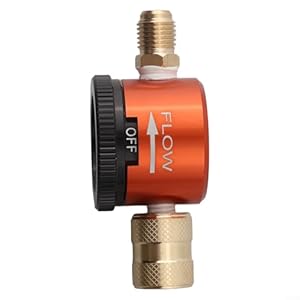The 10 Best Offers for Brazing Device - December 2025
We already helped 10 million customers this year!
- Customizable PCB Support: The rail sliding mechanism of this PCB holder allows multi-angle adjustability for a reliable and vibration-free grip on various PCB sizes, increasing efficiency in prototyping or troubleshooting electronics under challenging conditions.
- STURDY SHAPE Made of sturdy materials, the PCB holder ensures increased durability and retains its shape without warping. This ensures consistent performance with repeated use for organizing or repairing electronic components, keeping the metal construction long term and minimizing damage from wear and tear.
- PORTABLE TO USE Thanks to the easy storage and compact footprint, this soldering stand is lightweight and portable and provides instant readiness. It supports a seamless project flow indoors and outdoors, making it versatile for mobile applications. The portable features ensure tools are organised and always ready for immediate use.
- Lightweight and intuitive: The PCB holder offers a sticky residue removal area and accessory storage compartments that promote efficiency-enhancing layout and keep tools and components neatly organized. This ensures a smooth workflow for assembly or repair tasks in electronics, no matter what workshop environment. The clear design helps to avoid interruptions and increase productivity by ensuring a smooth
- PRECISE ALIGNMENT SYSTEM The PCB holder for soldering ensures ultra-high alignment accuracy through integrated chip alignment slots that minimize errors during repairs and improve precision in calibration tasks. This makes it ideal for demanding electronics projects that require high accuracy, thus supporting reliability when working with PCBs.
| Colour | Manufacturer | Weight |
| Single Attributes | Generisch | - |

- [HEAT RESISTANT DESIGN] This silicone mat can withstand high temperatures, making it for soldering and brazing tasks without losing its integrity.
- [ANTI STATIC PROTECTION] Equipped with anti-static features, this mat protects delicate electronic devices from electrostatic discharge during repairs.
- [AMPLE WORKSPACE] With generous dimensions of 34x23cm, it provides plenty of room for soldering irons, tools, and gadgets, enhancing your efficiency.
- [STABLE COMPONENT HOLDING] The mat's keeps small components and tools in place, reducing the risk of misplacement during intricate repair tasks.
- [MULTI-PURPOSE APPLICATION] Suitable for a variety of electronics including phones, watches, and computers, this mat is perfect for any repair enthusiast.
| Colour | Manufacturer | Weight |
| as picture show | Homeponnew | 206 g |

- [RESILIENT TO HEAT] This mat withstands high temperatures, making it an excellent choice for soldering and brazing without losing integrity.
- [ANTI-STATIC FUNCTIONALITY] Provides reliable protection against electrostatic discharge to keep delicate electronics safe during repairs.
- [GENERIOUS WORK AREA] With its dimensions of 35x25cm, the mat creates a spacious environment for your soldering tools and devices to enhance workflow efficiency.
- [COMPONENT SECURITY] Designed to hold small components firmly in place to prevent them from rolling away or becoming lost during your projects.
- [MULTIFUNCTIONAL MAT] Perfectly suited for various electronic repairs such as phones, watches, computers, catering to both hobbyists and professionals.
| Colour | Manufacturer | Weight |
| As Picture Show | DAZZLEEX | 245 g |

- [ HEAT RESISTANCE] This soldering mat withstands high temperatures without losing integrity, making it perfect for both soldering and brazing applications.
- [ANTI-STATIC SAFEGUARDS] Designed to prevent electrostatic discharge, this mat ensures that your sensitive electronic devices remain safe during repair tasks.
- [SPACIOUS AND FUNCTIONAL] With dimensions of 31x21cm, it provides an expansive workspace that accommodates all necessary tools and electronic devices comfortably.
- [COMPONENT STABILITY] Its design effectively holds small components in place to minimize the risk of loss or misplacement during intricate repair work.
| Colour | Manufacturer | Weight |
| As Picture Show | HEBEOT | 140 g |

- [HIGH TEMPERATURE RESISTANCE] Engineered to endure extreme heat, this mat is perfect for all your soldering and brazing needs without compromising its structure.
- [ELECTROSTATIC DISCHARGE SAFE] Offers essential protection against electrostatic discharge, safeguarding sensitive electronic components during repairs.
- [SPACIOUS WORK AREA] With dimensions of 31x21cm, this mat provides ample room for all your tools and devices, making repairs more efficient.
- [STABILITY FOR SMALL PARTS] Designed to hold small parts securely in place, reducing the risk of losing important components during work.
- [MULTIFUNCTIONAL USES] for repairing various electronics like phones and computers; suitable for both DIY enthusiasts and professional technicians.
| Colour | Manufacturer | Weight |
| As Picture Show | Oceanlend | 130 g |

- [ HEAT RESISTANCE] This silicone soldering mat withstands high temperatures, it remains intact during intense soldering .
- [ANTI-STATIC FUNCTIONALITY] Safeguards fragile electronic components from electrostatic discharge risks while performing repairs or modifications.
- [SPACIOUS DIMENSIONS] With a size of 35x25cm, it provides sufficient room for all your tools and devices, allowing for efficient workspace management.
- [COMPONENT STABILITY] The mat's design prevents small parts from rolling away or becoming misplaced during complex repair tasks.
| Colour | Manufacturer | Weight |
| as picture show | ZWEquipint | 245 g |

- USER-FRIENDLY DIAL SYSTEM: Equipped with a convenient 3 point position dial, this nitrogen purge tool allows users to easily switch between purging, brazing, and shut-off modes for optimal nitrogen flow management
- STANDARD CONNECTION PORT: Features a 1/4 inch port that connects effortlessly to standard nitrogen pressure regulators
- Complete your flushing and brazing tasks quickly by attaching a hose in the off position
- EFFECTIVE DEBRIS REMOVAL: This tool promotes the smooth introduction of nitrogen into pipelines during purging and brazing processes, effectively clearing debris and oxidation-related issues
- PRECISE PRESSURE CONTROL: Operating at an inlet pressure of 50psi and up to 200psi maximum pressure, this tool provides accurate control over nitrogen flow for consistent purging and brazing results while reducing gas waste
| Colour | Manufacturer | Weight |
| As Picture | Honseadek | - |

- [SAFETY PROTECTION] Built with an advanced check valve system that effectively prevents dangerous reverse gas flow and flashbacks. This critical safety feature protects your welding equipment and work environment from potential accidents while maintaining optimal gas pressure.
- [HIGH ACCURACY MEASUREMENT] With an impressive accuracy of 0.02mm, this tool delivers precise readings every time. Its shockproof design minimizes errors, ensuring reliable performance in various measuring tasks, from small jewelry to larger industrial components.
- [DURABLE CARBON STEEL CONSTRUCTION] Crafted from high hardness carbon steel, this Vernier Caliper is built to last. The rustproof coating enhances durability, making it resistant to wear and tear even in demanding environments, ensuring long term use.
- [MULTIFUNCTIONAL MEASURING TOOL] Effortlessly measure length, inner and outer diameters, and depth with this versatile caliper. Its user friendly design makes it for a wide range of applications, including jewelry making, engineering, and DIY projects.
- [ESSENTIAL FOR VARIOUS APPLICATIONS] A must have tool for home workshops, industrial settings, and craft studios. for measuring stones, beads, gems, and other small objects, this Vernier Caliper is a reliable companion for all your precision measurement needs.
| Colour | Manufacturer | Weight |
| - | Adfaga | - |

- [HEAT RESISTANT DESIGN] This mat withstands high temperatures, making it an choice for soldering and brazing without losing its integrity during intense applications.
- [MAGNETIC HOLDING FEATURE] The mat's magnetic keeps small components and tools securely in place, them from rolling away or getting lost during your repair tasks.
- [ANTI-STATIC PROTECTION] Designed to safeguard delicate electronic devices, this mat provides effective protection against electrostatic discharge during repairs.
- [ APPLICATIONS] Perfect for various electronic repairs, this mat is suitable for soldering, brazing, and working on devices like phones, watches, and computers.
- [SPACIOUS WORK AREA] Measuring 30x20cm, the mat offers ample workspace for comfortably accommodating soldering irons, tools, and electronic devices to enhance your repair efficiency.
| Colour | Manufacturer | Weight |
| As Picture Show | Lastdaytime | 117 g |

- 1/4 Inch Nitrogen Purge Tool: Features a 3-point position dial for quick switching between purging, brazing, and shut-off modes; enables precise nitrogen flow control during For HVAC system maintenance, reducing oxidation risk and supporting clean pipeline operations.
- Connector Regulator for HVAC Equipment: Brass-built nitrogen purge tool with a 1/4 inch port that connects directly to standard nitrogen pressure regulators; compatible with general 1/4 inch hoses for fast setup in field applications.
- For HVAC Equipment Maintenance: Designed to function under 50 PSI inlet pressure with a maximum rating of 200 PSI, this red-purged connector regulator delivers stable performance during flushing and brazing, minimizing gas wastage and improving job efficiency.
- 1/4 Inch Connector: The compact purge tool facilitates smooth nitrogen introduction into copper lines, helping forestall oxidation buildup and potential equipment failure; For ideal for use in residential and commercial For HVAC service workflows.
- Nitrogen Purge Tool Functionality: For Durable brass construction ensures long-lasting reliability in high-demand environments; lightweight design allows For easy handling while maintaining consistent operation across repeated maintenance cycles.
| Colour | Manufacturer | Weight |
| - | Bebykilemi | - |

General information about Brazing Device:
Brazing devices are essential tools used in various industries for joining metal parts together by melting a filler metal and then cooling it to bond the parts. This process, known as brazing, provides a strong and durable joint that is resistant to high temperatures and has excellent mechanical properties. Brazing devices are widely used in automotive, aerospace, electronics, and plumbing industries, among others.
One of the key components of a brazing device is the gas torch. The torch provides the necessary heat to melt the filler metal and create the bond between the metal parts. Brazing devices also include a fuel gas supply and an oxygen supply, which are used to create the flame required for heating. These devices may use various types of fuel gases, such as acetylene, propane, or natural gas, depending on the specific application.
In addition to the torch and fuel supply, brazing devices often have additional features to ensure efficient and precise brazing. Temperature controls and regulators allow users to adjust the heat output to meet the specific requirements of the brazing process. Some brazing devices also have integrated safety features, such as flame sensors and automatic shut-off valves, to prevent accidents and ensure user safety.
The use of brazing devices offers several advantages over other joining methods. Brazed joints are known for their high strength and resistance to vibration and thermal cycles. This makes them particularly suitable for applications exposed to harsh conditions, such as parts used in jet engines or automotive exhaust systems. Brazing also allows the joining of dissimilar metals, expanding the range of applications in which it can be used.
In conclusion, brazing devices are essential tools used in various industries for joining metal parts together. They utilize gas torches, fuel gas supplies, and oxygen supplies to provide the necessary heat for melting the filler metal and creating strong, durable bonds. With their numerous features and advantages, brazing devices play a crucial role in facilitating efficient and reliable joining processes across a wide range of applications.
** "Free Delivery" means that this is possible under the given conditions at the time of data retrieval from the relevant provider, but cannot be guaranteed. It is technically not possible to provide information in real-time. The shipping costs may vary under certain circumstances (different provider, place of delivery, etc.). The shipping costs shown in the further ordering process apply.
Other IMPORTANT INFORMATION that we ask you to take note of:
We may receive a commission if you make a purchase via the links on our site. This has no impact on the placement of the products on our site. Our website is part of amazon associates program - Amazon, Amazon Prime, the Amazon Logo and Amazon Prime Logo are registered trademarks of Amazon, Inc. or its affiliates.
Disclaimer:
1. The prices shown may have risen since the time we last updated them.
2. The actual price of the product on the seller’s site at the time of purchase will govern the sale.
3. It is not technically possible for the prices displayed above to be updated in real-time.










